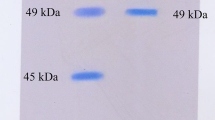Abstract.
Two new enzymes which hydrolyse D-alanyl-p-nitroanilide have been detected in Ochrobactrum anthropi LMG7991 extracts. The first enzyme, DmpB, was purified to homogeneity and found to be homologous to the Dap protein produced by O. anthropi SCRC C1-38 (ATCC49237). The second enzyme, DmpA, exhibits a similar substrate profile when tested on p-nitroanilide derivatives of glycine and L/D-alanine, but the amounts produced by the Ochrobactrum strain were not sufficient to allow complete purification. Interestingly, the DmpA preparation also exhibited an L-aminopeptidase activity on the tripeptide L-Ala-Gly-Gly but it was not possible to be certain that the same protein was responsible for both p-nitroanilide and peptide hydrolysing activities. The gene encoding the DmpA protein was cloned and sequenced. The deduced protein sequence exhibits varying degrees of similarity with those corresponding to several open reading frames found in the genomes of other prokaryotic organisms, including Mycobacteria. None of these gene products has been isolated or characterised, but a tentative relationship can be proposed with the NylC amidase from Flavobacterium sp. K172.
Similar content being viewed by others
Author information
Authors and Affiliations
Additional information
Received 7 December 1998; received after revision 15 March 1999; accepted 22 March 1999
Rights and permissions
About this article
Cite this article
Fanuel, L., Thamm, I., Kostanjevecki, V. et al. Two new aminopeptidases from Ochrobactrum anthropi active on D-alanyl-p-nitroanilide. CMLS, Cell. Mol. Life Sci. 55, 812–818 (1999). https://doi.org/10.1007/s000180050334
Published:
Issue Date:
DOI: https://doi.org/10.1007/s000180050334




